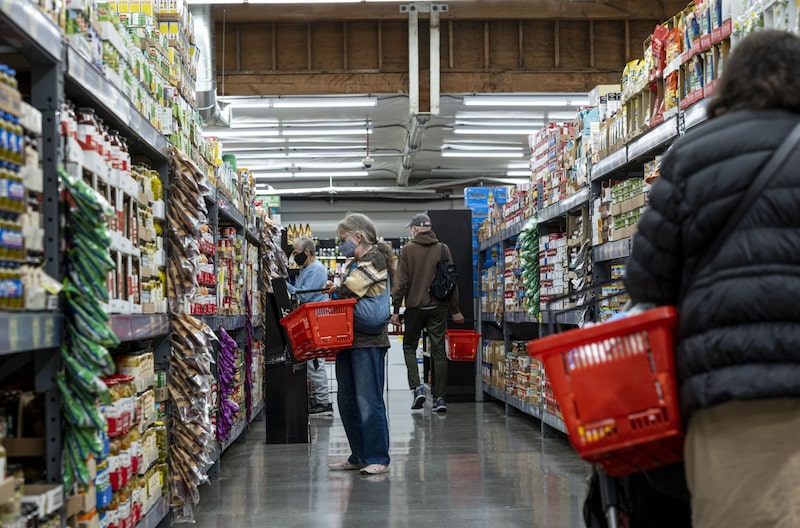Bloomberg — As the cost of living in the US has gone up, government subsidies to help people pay for basics have disappeared one-by-one. Up next on the chopping block: Emergency allotments of a food-assistance program that supports 30 million Americans living in 32 states.
Enhanced benefits for the Supplemental Nutrition Assistance Program, or SNAP, are ending in February, meaning families and individuals will get at least $95 less per month, with some seeing cuts of $250-a-month or more. Households with kids will, on average, lose out on an extra $223 each month, according to the Center on Budget and Policy Priorities, a nonpartisan research and policy institute.
As of early February, New Jersey was the only state that had plans to top up benefits for its residents as the federal program winds down.
Through SNAP, low-income families and individuals receive cash benefits loaded onto a card that can be used to buy groceries at authorized stores. The cuts will hit as inflation continues to send food prices in the US to new highs. Though there are signs that inflation has peaked, food prices were up 10.1% in January from a year ago. A dozen eggs now cost more than a pound of ground beef — for the first time on record.
“Right now people are really up against it,” said Ellen Vollinger, SNAP director at the Food Research & Action Center, an anti-hunger advocacy group. “There’s not a lot of cushion to absorb this.”
Americans have slowly seen pandemic-era benefits disappear over the last year and a half. A few months after expanded unemployment benefits ended, extended child tax credits went away, too. Universal free school lunch got cut last fall. Next month, families receiving benefits under the Women, Infants, and Children, or WIC, program, will no longer be able to use waivers to buy baby formula from different manufacturers, instead of just the one their state is contracted with.
All this has hit low-income Americans, who rely most on government support, particularly hard just as the price of just about everything has spiked in the last year.
“There aren’t more corners to cut,” said Cee Williams, a 45-year-old from the Bronx, New York, whose SNAP benefits will shrink come March.
Emergency allotments kept 4.2 million people above the poverty line in the last quarter of 2021, cutting poverty by 10%. Declines were highest for Black and Latino Americans, both populations that typically have higher rates of food insecurity as is. Almost 4 million children were lifted out of poverty because of monthly payments to families.
The consultant and graduate student said the $260 a month she got from the program helped subsidize groceries so she could afford her medical expenses. In February, she got an automated text from her benefits administrator saying to expect less next month. She’s still waiting for more details on how much less she’ll get.
“I’m just going to eat less food, honestly,” she said.
A bounty of government cash helped alleviate economic inequality in the US during the early years of the pandemic. A 2022 study found that the emergency allotments kept 4.2 million people above the poverty line in the last quarter of 2021, cutting poverty by 10%.
Declines were highest for Black and Latino Americans, both populations that typically have higher rates of food insecurity as is. Almost 4 million children were lifted out of poverty because of monthly payments to families.
As that government stimulus has disappeared, poverty and food insecurity have rebounded. Data from the US Census Bureau showed that 11.2% of adults said they sometimes or often didn’t have enough to eat in January, compared to 9.8% in April and May 2020. Separate figures from the Urban Institute estimate roughly one in five US adults experienced food insecurity in the middle of 2022 when inflation peaked, rebounding to the share reported during the early days of the pandemic.
In 18 states, enhanced SNAP benefits already expired, offering a preview of what’s to come nationwide. Propel, a tech company that surveys SNAP users monthly, found that those living in states without the extra benefits were more likely to skip meals, eat less or rely on others for food than those that still had the boost in place. A January survey of 4,100 SNAP recipients across the country found that 23% had visited a food pantry and 29% had skipped meals in the last month, both increases from December.
More money spent on food leaves less for other basics, which can hit children, people who are disabled and the elderly particularly hard.
“It’s not just their food money. Now they’re going to take it out of their medicine money, or their heating, or their electrical bills,” said Beth Shapiro, executive director of Citymeals on Wheels, a nonprofit that delivers meals to elderly New Yorkers. “It becomes a real health issue.”
— With assistance by Alexandre Tanzi
Read more at Bloomberg.com



